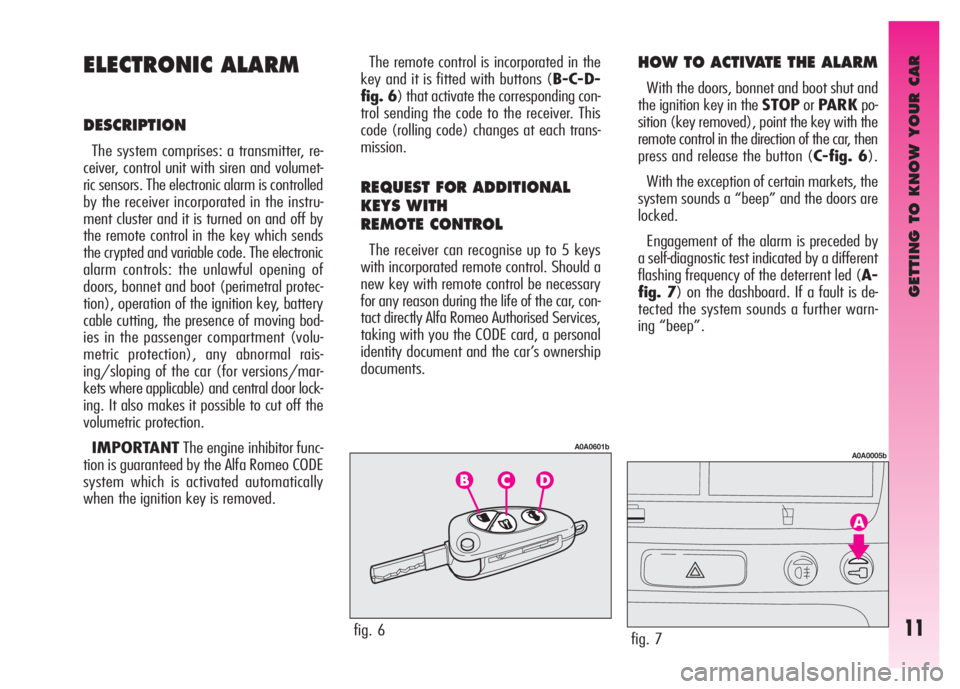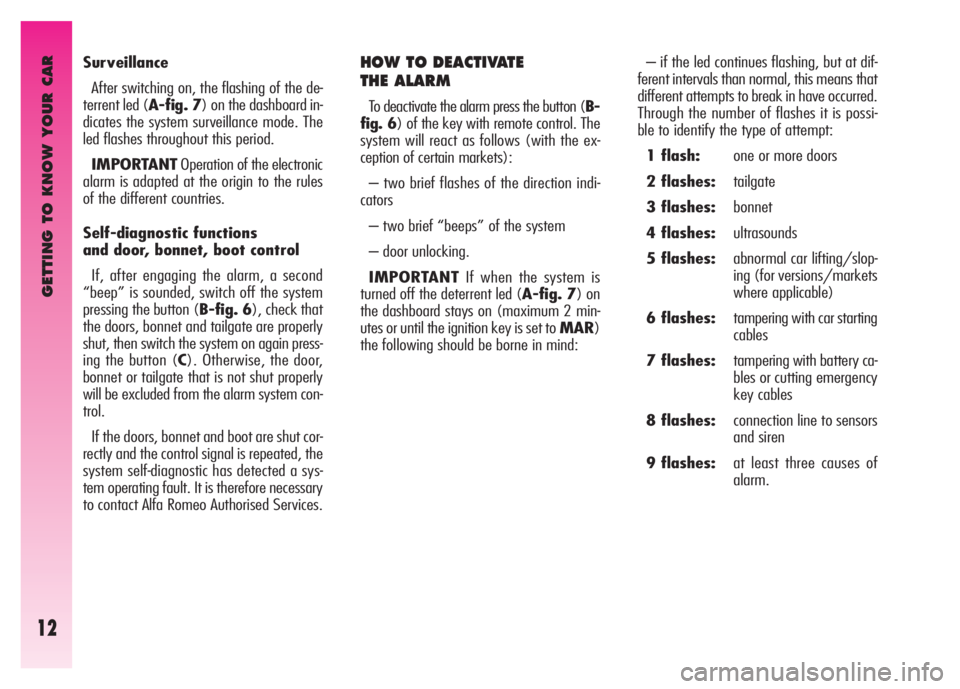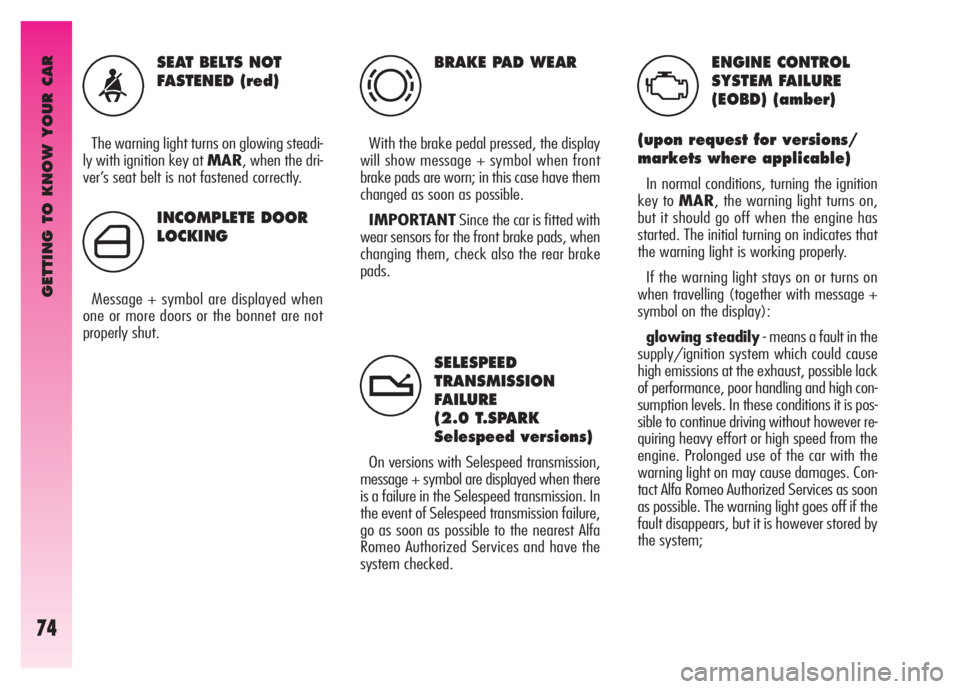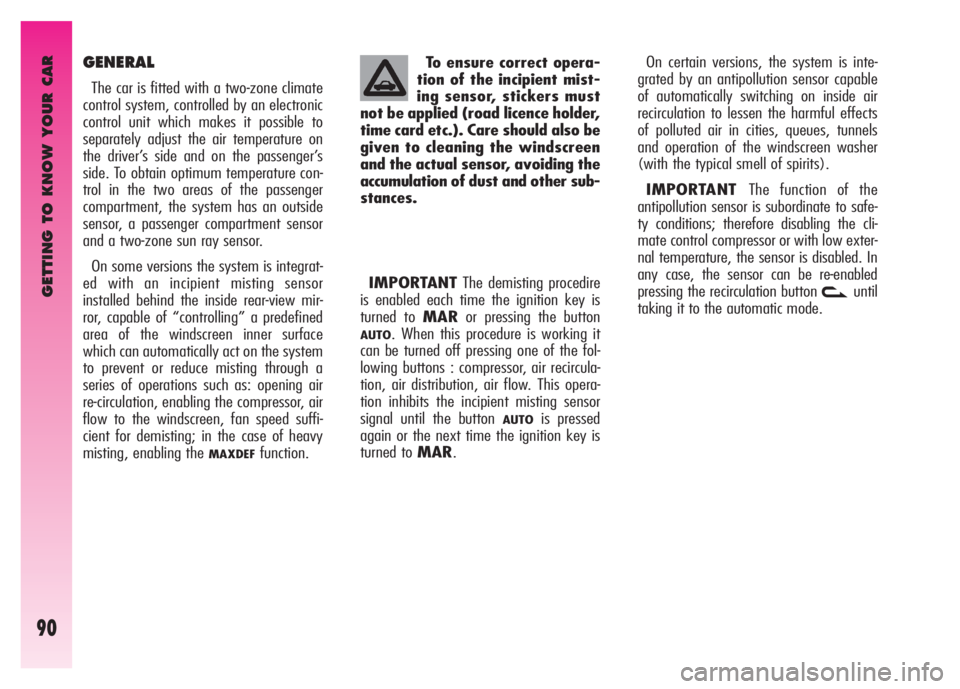sensor Alfa Romeo GT 2007 Owner handbook (in English)
[x] Cancel search | Manufacturer: ALFA ROMEO, Model Year: 2007, Model line: GT, Model: Alfa Romeo GT 2007Pages: 271, PDF Size: 5.57 MB
Page 10 of 271

GETTING TO KNOW YOUR CAR
8
The button B should only
be pressed when the key is
away from the body, in
particular from the eyes, and from
objects that can be spoilt (clothes
for instance). Make sure the key
can never be touched by others, es-
pecially children, who may inad-
vertently press the button.
OPENING THE TAILGATE
The tailgate can be opened from outside by
remote control pressing button (E), even if the
electronic alarm is on. Opening of the tailgate
is accompanied by the direction indicators
flashing twice; closing is accompanied by a
single flash.
If the electronic alarm is fitted, when the
tailgate is opened the alarm system switch-
es off volumetric protection and the tailgate
control sensor, the system (with the excep-
tion of versions for certain markets) “beeps”
twice.
Closing the tailgate again, the control func-
tions are restored, the system “beeps” twice
(with the exception of certain markets). The metal insert (A) of the key operates:
– the ignition switch
– driver’s door lock and, upon request for
versions/markets where applicable, the pas-
senger’s door lock
– the passenger’s side Air bag deactiva-
tion switch
To bring the metal insert out of the key
grip, press the button (B).
To pull out the hook ring (F) use a finely
pointed object (e.g. pen) and work in the
direction of the arrow.
To insert the metal insert in the key grip:
– keep the button (B) pressed
– move the metal insert (A)
– release the button (B) and turn the met-
al insert (A) until hearing the click as it locks
into place.
To unlock the doors by remote control press
button (C), the doors unlock and the direc-
tion indicators flash twice. To lock the doors
by remote control, press button (D), the
doors lock and the direction indicators flash
once. Pressing button (C) the doors are re-
leased, if within the next 60 seconds a door
or the tailgate are not opened, the system au-
tomatically locks everything again.
On cars fitted with electronic alarm system,
pressing button (C) turns it off, pressing but-
ton (D) turns it on.
Page 13 of 271

GETTING TO KNOW YOUR CAR
11
ELECTRONIC ALARM
DESCRIPTION
The system comprises: a transmitter, re-
ceiver, control unit with siren and volumet-
ric sensors. The electronic alarm is controlled
by the receiver incorporated in the instru-
ment cluster and it is turned on and off by
the remote control in the key which sends
the crypted and variable code. The electronic
alarm controls: the unlawful opening of
doors, bonnet and boot (perimetral protec-
tion), operation of the ignition key, battery
cable cutting, the presence of moving bod-
ies in the passenger compartment (volu-
metric protection), any abnormal rais-
ing/sloping of the car (for versions/mar-
kets where applicable) and central door lock-
ing. It also makes it possible to cut off the
volumetric protection.
IMPORTANTThe engine inhibitor func-
tion is guaranteed by the Alfa Romeo CODE
system which is activated automatically
when the ignition key is removed.The remote control is incorporated in the
key and it is fitted with buttons (B-C-D-
fig. 6) that activate the corresponding con-
trol sending the code to the receiver. This
code (rolling code) changes at each trans-
mission.
REQUEST FOR ADDITIONAL
KEYS WITH
REMOTE CONTROL
The receiver can recognise up to 5 keys
with incorporated remote control. Should a
new key with remote control be necessary
for any reason during the life of the car, con-
tact directly Alfa Romeo Authorised Services,
taking with you the CODE card, a personal
identity document and the car’s ownership
documents.
HOW TO ACTIVATE THE ALARM
With the doors, bonnet and boot shut and
the ignition key in the STOPorPARKpo-
sition (key removed), point the key with the
remote control in the direction of the car, then
press and release the button (C-fig. 6).
With the exception of certain markets, the
system sounds a “beep” and the doors are
locked.
Engagement of the alarm is preceded by
a self-diagnostic test indicated by a different
flashing frequency of the deterrent led (A-
fig. 7) on the dashboard. If a fault is de-
tected the system sounds a further warn-
ing “beep”.
fig. 6
A0A0601b
fig. 7
A0A0005b
Page 14 of 271

GETTING TO KNOW YOUR CAR
12
– if the led continues flashing, but at dif-
ferent intervals than normal, this means that
different attempts to break in have occurred.
Through the number of flashes it is possi-
ble to identify the type of attempt:
1 flash:one or more doors
2 flashes:tailgate
3 flashes:bonnet
4 flashes:ultrasounds
5 flashes:abnormal car lifting/slop-
ing (for versions/markets
where applicable)
6 flashes:tampering with car starting
cables
7 flashes:tampering with battery ca-
bles or cutting emergency
key cables
8 flashes:connection line to sensors
and siren
9 flashes:at least three causes of
alarm. Surveillance
After switching on, the flashing of the de-
terrent led (A-fig. 7) on the dashboard in-
dicates the system surveillance mode. The
led flashes throughout this period.
IMPORTANTOperation of the electronic
alarm is adapted at the origin to the rules
of the different countries.
Self-diagnostic functions
and door, bonnet, boot control
If, after engaging the alarm, a second
“beep” is sounded, switch off the system
pressing the button (B-fig. 6), check that
the doors, bonnet and tailgate are properly
shut, then switch the system on again press-
ing the button (C). Otherwise, the door,
bonnet or tailgate that is not shut properly
will be excluded from the alarm system con-
trol.
If the doors, bonnet and boot are shut cor-
rectly and the control signal is repeated, the
system self-diagnostic has detected a sys-
tem operating fault. It is therefore necessary
to contact Alfa Romeo Authorised Services.HOW TO DEACTIVATE
THE ALARM
To deactivate the alarm press the button (B-
fig. 6) of the key with remote control. The
system will react as follows (with the ex-
ception of certain markets):
– two brief flashes of the direction indi-
cators
– two brief “beeps” of the system
– door unlocking.
IMPORTANTIf when the system is
turned off the deterrent led (A-fig. 7) on
the dashboard stays on (maximum 2 min-
utes or until the ignition key is set to MAR)
the following should be borne in mind:
Page 30 of 271

GETTING TO KNOW YOUR CAR
28
Rear seat belts shall be worn as shown in
fig. 38.Fig. 39shows improper belt fas-
tening. To tilt the back rest see paragraph
“Boot extension”.
IMPORTANTThe centre rear seatbelt is
installed on request only for versions/mar-
kets on which it is required.
IMPORTANTRemember that, in the
event of an accident, any passengers occu-
pying the rear seats who are not wearing
a seat belt not only subject themselves to
great personal risk, but constitute a danger
to the occupants of the front seats.PRE-TENSIONING DEVICES
To increase the efficiency of the front seat
belts, the car is fitted with pre-tensioning de-
vices. These devices “feel” that the car is
being subject to a violent impact by way of
a sensor and rewind the seat belts a few
centimetres. In this way they ensure that
the seat belt adheres to the wearer before
the restraining action begins.
The seat belt locks to indicate that the de-
vice has intervened; the seat belt cannot be
drawn back up even when guiding it man-
ually.
IMPORTANTThe pretensioner will give
maximum protection when the seat belt ad-
heres snugly to wearer’s chest and hips.
fig. 39
A0A0387b
fig. 38
A0A0386b
fig. 37
A0A0686b
REAR BELTS
To fasten the belt: gently pull the belt from
its reel and guide the tape to prevent it from
twisting, then insert the tongue (A-fig. 37)
into the buckle housing (B).
To unfasten the seat belts, press button (E).
Page 50 of 271

GETTING TO KNOW YOUR CAR
48
At each start, the rain sensor automatically
stabilises at a temperature of about 40°C
to eliminate any condensation from the con-
trol surface and prevent the formation of ice.
The rain sensor is able to detect and au-
tomatically adapt to the presence of the fol-
lowing particular conditions which require
different sensitivity:
– impurities on the control surface (salt,
dirt, etc.);
– streaks of water caused by worn wiper
blades;
– difference between day and night (the
human eye is more disturbed during the
night by the wet glass surface). Rain sensor (fig. 64)
The rain sensor (A), fitted only on cer-
tain versions, is an electronic device com-
bined with the windscreen wiper which has
the purpose of automatically adjusting the
number of wipes during intermittent opera-
tion to the intensity of the rain.
All the other functions controlled by the
right-hand lever remain unchanged.
The rain sensor is activated automatically
moving the right-hand lever to position (B-
fig. 62) and it has a range of adjustment
that gradually varies between wiper sta-
tionary (no wiping) when the windscreen is
dry, to wiper at first continuous speed (con-
tinuous, slow) with heavy rain.Turning the knurled ring (F-fig. 62) it
is possible to increase the sensitivity of the
rain sensor, obtaining a quicker change from
stationary, when the windscreen is dry, to
first continuous speed (continuous, slow).
Operating the windscreen washer with the
rain sensor activated (lever at position B)
the normal washing cycle is performed at
the end of which the rain sensor resumes its
normal automatic function.
Turning the ignition key to STOPthe rain
sensor is deactivated and the next time the
engine is started (MARposition) it will not
be reactivated even if the lever has remained
in position (B). In this case to activate the
rain sensor, simply move the lever to (A)
or (C) and then back to (B).
When the rain sensor is reactivated in this
way, the wiper performs at least one stroke,
even if the windscreen is dry, to indicate that
reactivation has occurred.
The rain sensor is located behind the inner
rear-view mirror in contact with the wind-
screen and inside the area cleaned by the
wiper and it controls an electronic control
unit which in turn controls the wiper motor.
fig. 64
A0A0331b
Page 76 of 271

GETTING TO KNOW YOUR CAR
74
BRAKE PAD WEAR
With the brake pedal pressed, the display
will show message + symbol when front
brake pads are worn; in this case have them
changed as soon as possible.
IMPORTANTSince the car is fitted with
wear sensors for the front brake pads, when
changing them, check also the rear brake
pads.
SELESPEED
TRANSMISSION
FAILURE
(2.0 T.SPARK
Selespeed versions)
On versions with Selespeed transmission,
message + symbol are displayed when there
is a failure in the Selespeed transmission. In
the event of Selespeed transmission failure,
go as soon as possible to the nearest Alfa
Romeo Authorized Services and have the
system checked.
ENGINE CONTROL
SYSTEM FAILURE
(EOBD) (amber)
(upon request for versions/
markets where applicable)
In normal conditions, turning the ignition
key to MAR, the warning light turns on,
but it should go off when the engine has
started. The initial turning on indicates that
the warning light is working properly.
If the warning light stays on or turns on
when travelling (together with message +
symbol on the display):
glowing steadily- means a fault in the
supply/ignition system which could cause
high emissions at the exhaust, possible lack
of performance, poor handling and high con-
sumption levels. In these conditions it is pos-
sible to continue driving without however re-
quiring heavy effort or high speed from the
engine. Prolonged use of the car with the
warning light on may cause damages. Con-
tact Alfa Romeo Authorized Services as soon
as possible. The warning light goes off if the
fault disappears, but it is however stored by
the system;
SEAT BELTS NOT
FASTENED (red)
The warning light turns on glowing steadi-
ly with ignition key at MAR, when the dri-
ver’s seat belt is not fastened correctly.
INCOMPLETE DOOR
LOCKING
Message + symbol are displayed when
one or more doors or the bonnet are not
properly shut.
t
U
Page 82 of 271

GETTING TO KNOW YOUR CAR
80
WARNING LIGHTS
FAILURE
The message will be displayed when one
of the following warning lights is failing: ABS
warning light, EBD warning light, ASR warn-
ing light, VDC warning light.
ENGINE OIL
LEVEL SENSOR
The warning light turns on when a fault
is detected to the engine oil level sensor.
Contact Alfa Romeo Authorized Services as
soon as possible to have the failure elimi-
nated.
SPEED LIMIT EXCEEDED
The display will show the dedicated mes-
sage + symbol and the buzzer will sound
when the car exceeds the speed limit set
previously (see “Reconfigurable multifunc-
tion display”).
RANGE (Trip Computer)
The display will show the dedicated mes-
sage + symbol when the cruising range is
less than 50 km.
SCHEDULED SERVICING
The display will show the dedicated mes-
sage starting from 2000 km from the dead-
line planned in the Service Schedule. The
message will be repeated every 200 km
when turning the ignition key to MAR.
POSSIBLE
PRESENCE
OF ICE
ON THE ROAD
The display shows message + symbol √and a buzzer will sound when the outside
temperature reaches or falls below 3°C to
warn the driver of the possible presence of
ice on the road.
The buzzer will sound for approx. 2 sec-
onds whereas the message will stay on the
display for aprrox. 10 seconds then, only
the symbol will stay displayed until tem-
perature exceeds 6°C or until the engine
is switched off.
If when travelling, next to the indication
of possible ice on road, the temperature will
raise above 6° C symbol
√will turn off. If
temperature falls again below 3° C a new
message (outside temperature flashing) +
symbol
√will be displayed together with
the sound of the buzzer.
√
Page 92 of 271

GETTING TO KNOW YOUR CAR
90
IMPORTANTThe demisting procedire
is enabled each time the ignition key is
turned to MARor pressing the button
AUTO. When this procedure is working it
can be turned off pressing one of the fol-
lowing buttons : compressor, air recircula-
tion, air distribution, air flow. This opera-
tion inhibits the incipient misting sensor
signal until the button
AUTOis pressed
again or the next time the ignition key is
turned to MAR.On certain versions, the system is inte-
grated by an antipollution sensor capable
of automatically switching on inside air
recirculation to lessen the harmful effects
of polluted air in cities, queues, tunnels
and operation of the windscreen washer
(with the typical smell of spirits).
IMPORTANT The function of the
antipollution sensor is subordinate to safe-
ty conditions; therefore disabling the cli-
mate control compressor or with low exter-
nal temperature, the sensor is disabled. In
any case, the sensor can be re-enabled
pressing the recirculation button
vuntil
taking it to the automatic mode. To ensure correct opera-
tion of the incipient mist-
ing sensor, stickers must
not be applied (road licence holder,
time card etc.). Care should also be
given to cleaning the windscreen
and the actual sensor, avoiding the
accumulation of dust and other sub-
stances.
GENERAL
The car is fitted with a two-zone climate
control system, controlled by an electronic
control unit which makes it possible to
separately adjust the air temperature on
the driver’s side and on the passenger’s
side. To obtain optimum temperature con-
trol in the two areas of the passenger
compartment, the system has an outside
sensor, a passenger compartment sensor
and a two-zone sun ray sensor.
On some versions the system is integrat-
ed with an incipient misting sensor
installed behind the inside rear-view mir-
ror, capable of “controlling” a predefined
area of the windscreen inner surface
which can automatically act on the system
to prevent or reduce misting through a
series of operations such as: opening air
re-circulation, enabling the compressor, air
flow to the windscreen, fan speed suffi-
cient for demisting; in the case of heavy
misting, enabling the
MAXDEFfunction.
Page 94 of 271

GETTING TO KNOW YOUR CAR
92
CONTROLS(fig. 97)
1- Inside temperature set display (dri-
ver’s side)
2- Inside temperature adjustment knob
(driver’s side)
3- Fan speed set and system off display
(
OFF)
4- Knob for adjusting the fan speed and
switching the system off
5- Inside temperature set display (pas-
senger’s side)
6- Inside temperature adjustment knob
(passenger’s side)
7- Maximum defrosting/demisting
on/off button for windscreen and front
side windows, rearscreen heating and
wing mirror coils (
MAX-DEFfunction)
8- Inside air re-circulation on/off button
v(manual/automatic)
9- Rearscreen heating and wing mirror
defrosting on/off button
(
10- Air distribution selection buttons 11- Inside air temperature sensor
12- Button for aligning the temperature
set on the passenger’s side with that on
the driver’s side
MONO
13- Button for selecting the system
automatic mode
AUTO
14- Climate control compressor on/off
enable button
√
fig. 97
A0A0090b
Page 103 of 271

GETTING TO KNOW YOUR CAR
101
INSIDE AIR RE-CIRCULATION
ON/OFF BUTTON
(fig. 107)
Inside air re-circulartion is controlled
according to three operating logics:
- automatic control, indicated by the
turning on of the right led on the button;
- forced engagement (inside air re-circu-
lation always on), indicated by the turning
on of the left led on the button (and by
the right led going off at the same time);
- forced switching off (inside air re-circu-
lation always off with air inlet from out-
side), indicated by the turning off of both
leds.
These operating conditions are obtained
pressing in sequence the inside air re-cir-
culation button (8)
v.
When inside air re-circulation is con-
trolled automatically by the system, the
right led on the air re-circulation button
(8)
vstays on all the time and the left
led shows the air re-circulation condition:
on= air re-circulation operating;
off= air re-circulation off.
If inside air re-circulation has been turned
on or off manually, the led on button
(13)
AUTOturns off. In automatic operation , inside air re-cir-
culation is turned automatically when the
antipollution sensor detects the presence
of polluted air, for example in cities,
queues, tunnels and operation of the
windscreen washer (with the typical smell
of spirits). The inside air- re-circula-
tion system makes it pos-
sible to reach the required
“heating” or “cooling” conditions
faster. It is however inadvisable to
use it on rainy/cold days as it
would considerably increase the
possibility of the windows misting
inside, especially if the climate con-
trol system is off.
A0A0212b
With low external tem-
perature the climate con-
trol compressor is unable
to work. It is therefore inadvisable
to use the inside air recirculation
function
vwith low outside tem-
perature as windows may mist
over quickly.
fig. 107